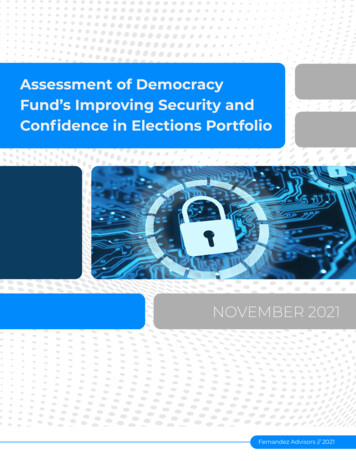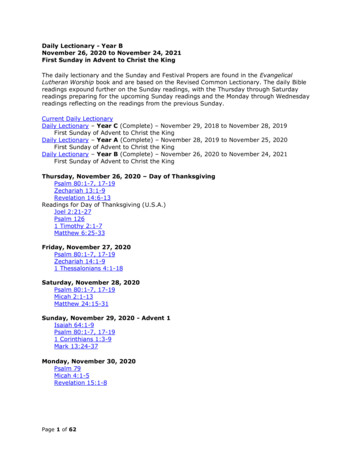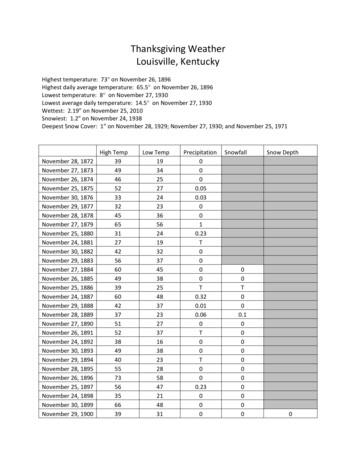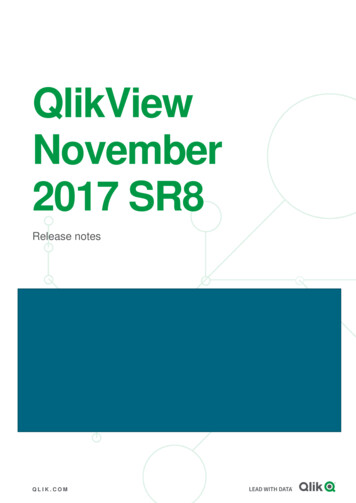
Transcription
NOVEMBER 2021Fernandez Advisors // 20211
TABLE OF CONTENTSExecutive Summary4Methodology4Findings Summarized5Which Democracy Fund investments were useful?5What made these investments useful?5What investments were adopted by government, what are their characteristics, andhow stable is continued government adoption?5State of the Field6Persistent and emerging gaps in the field6Background and Context7Findings and Analysis11Which Democracy Fund investments were useful?11The Belfer Center’s Tabletop Exercises and Cybersecurity Train the Trainer Modules11Tools and guides for election officials on how to administer post-election audits11On-call technical assistance available to election administrators12NGA Policy Academy sessions on cybersecurity and crisis communications planning13What made Democracy Fund investments useful?13Bridging siloes between levels and branches of local, state, and federal government13Support for cybersecurity capacity building for state and local election administrators14Practical tools applicable to on the ground needs of election administrators15Investments that demonstrate proof of concept16What investments were adopted by government, what are their characteristics, andhow stable is continued government adoption?16Tools proven in multiple jurisdictions17Tools solved a problem that government understood17Government adoption occurred after philanthropy and nonprofit partners assumedinitial risk to establish proof of concept17Tools need to be perceived as nonpartisan18Continued and increased government adoption is not ensured19Overarching Concerns21The scale of MDM threatens to reverse advances21Complacency on cybersecurity after a secure 2020 election222
TABLE OF CONTENTSPersistent and emerging gaps in the field23Threats are growing at the intersection of technology, cybersecurity, and MDM23Uncertainty on how to create accountability for social media platforms23Expanded voting options increase entry points for cyberattacks25There is a potentially symbiotic relationship between disinformation andcybersecurity attacks25Need for more technical assistance27The politicization of election administration27Growth in post-election audits fuels need for standards and support forelection administrators28Federal funding for election cybersecurity is inconsistent and insufficient29Need for message development and communications training for election officials30Lack of philanthropic support30Conclusion323
EXECUTIVE SUMMARYThe Democracy Fund contracted with Fernandez Advisors to assess its Improving Security and Confidencein Elections portfolio which is part of its Trust In Elections strategy. This strategy was created by DemocracyFund in 2017 in response to cyber threats to state and local election systems as well as declines in publicopinion measures of election integrity following the 2016 presidential election. The portfolio fundedprograms that would enable election officials to have the resources, knowledge, and will to execute physicaland digital defenses to secure election systems. The theory of change proposed that these investmentswould improve capacity to adapt and protect against ongoing threats to election systems and increasepublic confidence that elections are secure.Specifically, Democracy Fund wanted this assessment to answer a small number of questions: How do experts in the field perceive the impacts of different kinds of investments made within theportfolio? Were they useful? And why? Which efforts supported by Democracy Fund were adopted by government and why? For thoseinitiatives adopted by government are they stable and likely to continue through any political change? What changes are occurring in the field? What gaps exist?This executive summary describes the methodology used for the assessment and previews our keyfindings. The rest of the assessment does two things: Provides context for the current state of trust in elections by reviewing the last five years. Provides greater detail on each of the findings.MethodolgyIn June of 2021, Democracy Fund staff working on the Security and Confidence in Elections portfoliodeveloped a memo summarizing the history and key decision-points in this track of work. This was followedby a portfolio review meeting to further clarify how investments within the track of work fit into DemocracyFund’s theory of change. Both the memo and debriefing identified key issues and experts to include in thisassessment. Fernandez Advisors reviewed the memo and participated in the debriefing.Subsequently in August and September of 2021, Fernandez Advisors conducted qualitative interviewswith 22 election cybersecurity and election law experts, current and former government officials, andadvocates for secure and modern elections. We solicited their perspective on the current state of electioncybersecurity and trust in elections, as well as changes in the last five years and capacity gaps that remain.Some but not all of those interviewed were current or former grantees of Democracy Fund.From these interviews and the materials provided by Democracy Fund, Fernandez Advisors identified thestate of the field, the types of investments that appear most useful, and gaps that need to be filled.4
Findings SummarizedWhich Democracy Fund investments were useful?Interviewees expressed support and respect for Democracy Fund’s understanding of the field, andgenerally felt Democracy Fund’s investments were impactful. However, certain investments werehighlighted more frequently. These included: The Belfer Center’s Tabletop exercises and Cybersecurity Train the Trainer modules adapted forelection administrators. Practical tools and guides to election audits (including Risk-Limiting Audits), tailored for an electionadministrator audience and other practitioners. On-call technical assistance available to election administrators to assist with prioritizing cybersecurityand cyberhygiene plans and understanding and implementing post-election audits. Praise was notablefor no-cost expert support from The Elections Group. National Governors’ Association Policy Academy sessions focused on cybersecurity and crisiscommunications planning.What made these investments useful?Investments with the following characteristics generally rose to the top when experts were discussing value: Investments that recognized and sought to bridge siloes between levels and branches of local, state,and federal government, recognizing that a cross-agency model is often necessary given the nature ofelection administration, cybersecurity, and the diversity of threats. Investments that directly supported capacity building for state and local election administrators,especially in the areas of cybersecurity and cyberthreats. Tools that were more practical and that could be applicable to on the ground needs (as opposed tothose that might be more appropriate for discussion in academic settings). Investments that demonstrate proof of concept through working with a smaller number ofpilot projects or jurisdictions, and which can then ultimately reach scale, generally throughgovernment adoption. Interviewees appreciated Democracy Fund’s ability as a philanthropic institution to absorb therisks associated with innovation at a moment of high stakes and intense public scrutiny on electionprocesses and administrators. Interviewees pointed to monetary and reputational risks that stem frominvesting in new or unproven programs or approaches. Current and former government officials notedthat due to the accountability and public scrutiny that generally accompanies the use of public funds,government dollars are often not useful for initial tests of innovative tools or new approaches.What investments were adopted by government, what are their characteristics,and how stable is continued government adoption?Certain Democracy Fund supported activities were adopted by government. Characteristics that areconsistent with government adoption include:5
Tools were used in multiple jurisdictions, and thus clearly replicable. Tools solved a problem that government understood, for example the lack of coordination acrossdifferent levels of government and across different departments. Government adoption occurred after Democracy Fund and nonprofit partners assumed the risk toestablish proof of concept. Tools need to be perceived as nonpartisan. Alternatively, government’s leeriness for tools perceived aspartisan can lead to important improvements not being adopted.Continued government adoption of these types of tools is not ensured for at least two reasons: The potential for increased politicization of election administration. Instability of funding for cybersecurity specifically and election administration generally.State of the FieldInterviewees were proud of the progress on cybersecurity analysis and capacity built over the last five years.However, interviewees also raised key concerns: The scale of cyberthreats and attacks, as well as increases in misinformation, disinformation, andmalinformation (MDM) threaten to reverse advances made in the last five years. Respondents also expressed considerable apprehension at the resilience of unfounded attacks on theintegrity of the election process and their corrosive impact on Americans’ trust in elections and otherpublic institutions. While no respondents knew exactly what to do about organized misinformation,there was strong agreement on the need for a national and perhaps international mobilization tocounteract its effects. Many interviewees pointed to the threat of complacency on cybersecurity after a secure 2020 election,raising the prospect of insufficient future and sustained funding from the federal government tocontinue vigilance across the country.Persistent and Emerging Gaps in the FieldInterviewees pointed to an array of gaps that continue to characterize the field. These are generally tied to acombination of attacks on the field, the politicization of election administration, the changing role of audits,and ongoing financial gaps. Capacity gaps for election administrators are growing because of expanding threats. Many of thesegaps are at the intersection of technology, cybersecurity, and MDM. As more states expand mail voting, absentee voting, early voting and online registration, the entrypoints for bad actors to attack voter databases and public access portals expands significantly. There is an increasingly symbiotic relationship between misinformation and disinformation onthe one hand and cybersecurity threats and attacks on the other, with the two phenomenareinforcing each other.6
There is uncertainty on how to create accountability for social media platforms in stopping thespread of MDM. The politicization of election administration raised concerns for interviewees, as they foresee negativeimpacts on day-to-day elections operations, the proliferation of partisan election audits, and anundermining of the basic idea of nonpartisan election administration. Post-election audits and RLAs are here to stay, fueling a continued need for technical assistance andsupport for election administrators. State and local election officials need training, technical support, andaccess to best practices on audits. There is also a need for standards establishing the requirements of avalid post-election audit. There does not appear to be significant new election administration cybersecurity funding coming fromthe federal government. The field lacks message development and communications training for election officials. This gap ismore pronounced as attacks on election administration proliferate in television and social media. There is a lack of philanthropic support for election cybersecurity and post-election audit work. There isa need to convene funders to build support for this as well as for a communications campaign to helpbuild trust in elections.7
BACKGROUND AND CONTEXTThe 2016 United States presidential elections witnessed interference from foreign states and actors thatsought to influence the outcome of the election and sow distrust in democracy and democratic institutions.Foreign actors also leveraged material gained from cyberattacks to seed misinformation and confusionamong the electorate.Malware and other tools were used to break into state election system databases. The Illinois and Arizonavoter registration databases were breached — likely by Russian agents.1 Up to 500,000 individual voterrecords were potentially compromised in Illinois.2 Election officials in Durham County, North Carolinareported widespread problems with voter records and misleading messages sent to poll workers, possibleindications of a cybersecurity breach of a Florida company that provided data support for Durham Countye-poll books. 3 As one interviewee noted:“[We saw the] exposure of fundamental security weaknesses in our brittleelection infrastructure. Now that our adversaries saw how brittle it was,this exposed us to more threats and attacks on the operation side of ourinfrastructure. This is straining our democratic process.”Democracy Fund’s Trust In Elections strategy was started in 2017 in response to these types of cyberthreats to state and local election systems and concurrent declining levels of public trust in those systems.Following initial research, Democracy Fund chose to fund in four areas:Fortify the field with workable solutions and best practices, bolstered by research and collaborationbetween civic technologists, cybersecurity experts, and election officials.Empower election officials to advocate for greater funding to better protect and strengthenelection technology, while preserving the right to vote.Lead research efforts, and the dissemination of contingency policies, verification practices, andresiliency efforts (physical, digital, and process-based) for election officials.Lead public education efforts around the legitimate risks to election systems and thwart the abilityof malevolent actors to foster distrust by identifying and disseminating effective messages totrusted validators and the media.”Russian Interference in 2016 U.S, Elections”, nce-in-2016-u-s-elections, accessed November 15,2022.2Politico.com, “How Close Did Russia Really Come to Hacking the 2016 Election?”, December 26, 2019, did-russia-really-hack-2016-election-088171, accessed 10.5.213Politico.com, “How Close Did Russia Really Come to Hacking the 2016 Election?”, December 26, 2019, did-russia-really-hack 2016-election-088171, accessed 10.5.21.18
Democracy Fund’s initial grantmaking in thethird quarter of 2017, focused on buildingelection law resources, deterring foreigninfluence in elections, and producing electioncybersecurity research and best practices.Simultaneously, federal agencies began toinvestigate election cybersecurity failuresto understand how to shore up Americanelection systems and cybersecurityinfrastructure. In January of 2017, PresidentObama’s Secretary of the Department ofHomeland Security designated electionsinfrastructure as part of the nation’s criticalinfrastructure. This designation madeelection infrastructure a priority for federalcybersecurity assistance and protections.It was clear that there was a dearth ofelection cybersecurity infrastructurenationwide. Cybersecurity literacy andpreparedness were new terrain for many ofthe nearly 10,000 election jurisdictions acrossthe country. Election administrators faced alearning curve on cyberhygiene and systemsanalysis, and often lacked the capacity toaddress and avert potential cyberthreats.Collaboration across functions and levels ofgovernment needed to be established fromthe ground up.Throughout 2018, Democracy Fund madeinvestments to attempt to address thesegaps, via making available trainings, tools, andhands-on support for election administrators.In May of 2018, to address declining levels oftrust for the integrity of elections, DemocracyFund launched the Election Validation Projectand through this project produced a series ofhow-to guides called “Knowing It’s Right”. Thisproject sought to build public trust throughrigorous audits, standards, and testing ofelection results and systems. To facilitatethe project, Democracy Fund made a smallnumber of grants and hired expert consultantsto develop tools, materials, and trainings tosupport effective audits of elections.9 9
In November of 2018, Donald Trump signed the Cybersecurity and Infrastructure Security Agency Actinto law. This created within the Department of Homeland Security, the Cybersecurity and InfrastructureSecurity Agency (CISA). CISA is tasked with identifying and leading responses to cybersecuritythreats and vulnerabilities across the nation, including through coordinating cybersecurity effortswith state governments. Through CISA, expert support and technical resources are made availableto state and local election administrators to assess their cybersecurity preparedness and prepare forfuture cyberthreats.In 2018, 380 million in federal funding was appropriated for election security and cybersecuritypreparedness efforts via Help America Vote Act Election Security Funds. 4 State matching fundswere required for receipt of HAVA election security dollars. Another tranche of 425 million inelection security funding was appropriated in early 2020. This federal funding, in addition to someadditional federal support in 2020 via the CARES Act, was intended to provide support to state andlocal election jurisdictions for their proactive work to assess and protect their election infrastructurefrom cyberattacks.From January 2019 to January 2020, Democracy Fund made grants to organizations to support electionadministrators’ preparations for the 2020 election. The grantees continued to focus on addressingcybersecurity in campaigns and election administration, auditing tools, information sharing, and otherneeds of election officials. All of this was done while the global pandemic changed how everyone wasdoing their work and election administrators needed to accommodate changes in how people werevoting (with many more people voting early or via mail).Prior to and following the November election, a new phenomenon threatened public confidence inelections. Donald Trump adopted the position that the election was stolen and persistently repeatedclaims that election administration lacked integrity. Election workers were threatened. Election auditswere used for political purposes to attempt to demonstrate that Trump was cheated. Fortunately, allof these audits, no matter their quality, wound up demonstrating that the elections were free, fair, andaccurately decided.These false claims spread through social media, talk radio, and new television media outlets that werewilling to share misinformation on election administration, the precision of vote counts and accuracyof voting machines. On January 6, 2021, a coup was attempted as marauding rioters attacked CapitolPolice and ransacked the halls of Congress trying to stop the counting of electors and certification ofthe election. Fully eight Republican Senators, and 139 Republican House Members voted to overturnthe election of President Biden citing many of the same arguments that Trump, and his lawyers, madeunsuccessfully in courts around the country.Because this became the dominant post-election story, some key aspects of this election have notreceived as much attention. The election was hugely successful, with more people voting and higherpercentages of people voting than ever before. As well, more people and higher percentages of peoplevoted early and voted by mail than in any previous national election. Despite this growth in electoratesize and the complexity of managing an election during the pandemic, there were no major electioncybersecurity breaches. The tools, trainings, multi-level communications, and investments made bygovernment and private philanthropy to reduce risk appear to have been successful.4United States Election Assistance Commission, “Election Security Funds”, ecurity-funds,accessed 10.5.21.10
FINDINGS AND ANALYSISWhich Democracy Fund investments were useful?There were a number of tools and practices that resulted from Democracy Fund’s investments that werecited consistently by interviewees as having important impacts.The Belfer Center’s Tabletop Exercises and Cybersecurity Train theTrainer ModulesDemocracy Fund’s investments in tools and training resources adapted by the Belfer Center were cited bynearly all interviewees as having high impact for their work and for the field overall. These were identified ashighly impactful investments that supported effective collaboration across agencies, functions, and levels ofgovernment to bridge siloes. Belfer Center tools supported collaborating on response protocols, informationsharing, and scenario planning.The Belfer Center’s Train the Trainer models were seen as effective at responding to the need for tailoredand easily digestible training on cybersecurity. Election administrators in leadership positions appreciatedthat these trainings could be replicated by their staff working on the front lines.The Center’s Tabletop exercises, which adapted a simulation approach long used by government to dealwith natural disasters and military planning, continue to be used by various government agencies at thestate and federal level, including CISA and election administrators. The Belfer Center decided to end itscybersecurity training programs in 2020 to avoid duplication, as it felt other nonprofits including StanfordUniversity’s Center for International Security and Cooperation as well as the Center for Internet Security hadtaken on similar work.Tools and guides for election officials on how to administer postelection auditsPost-election audits, including Risk Limiting Audits (RLAs), are increasing in use. There are both good andbad reasons for this. Some states are legitimately trying to ensure secure and modern elections. In otherstates, politicians are attempting to legitimize erroneous concerns about “election integrity” and use auditsfor political purposes. 5Well run risk limiting audits are an important and legitimate way to ensure elections are run securely andthus build public trust. A serious concern is that when audits become politicized, best practices will not beused. The State of Arizona’s so-called “forensic audit” of Maricopa County did not follow best practices.Prior to 2017, when Colorado had its first statewide RLA, no state had conducted a statewide RLA. Since2018, seven additional states have implemented RLAs (CA, OH, WA, GA, IN, NV, OR). Four states (RI, MI, GA,5At the time of this report, the state legislatures of Pennsylvania and Wisconsin were both considering large-scale post-election audits to investigatethe validity of the 2020 election results. Three other states (Georgia, Michigan, and Arizona) conducted or considered post-election audits in specificcounties and specific voting mechanisms such as absentee ballots or voting machines alone. Information available at . Accessed 9.29.21.11
PA) conducted statewide RLAs in 2020, and multiple counties in three states (VA, CA, NV) completed RLAsin the same year. VotingWorks developed RLA software called Arlo that was used in 5 states in 2020. TheState of Washington brought on a dedicated staff person to begin implementing RLAs statewide in 2021—a resource commitment that interviewees believe will add significant capacity.There is real value in tools that support officials trying to manage audits effectively. Many electionadministrators found themselves scrambling in 2021 to facilitate audits, often for the first time andfrequently with little advance planning time. Democracy Fund supported and published a series ofreports from Jennifer Morell. These included Knowing It’s Right: Limiting the Risk of Certifying Elections6which explains the policy issues that underpin post-election audits, what state policymakers shouldconsider in this context, and an implementation guide for election administrators on post-election auditsand RLAs.Similarly, the Elections Group’s post-election audit tools and resources that explain and provide step-bystep implementation guidance were perceived by interviewees as responding to the evolving electionlandscape. Elections Group’s presentations at the 2021 conferences of the National Association of StateElection Directors and the National Association of Secretaries of State were pointed to by intervieweesas helpful to inform their understanding of post-election audits, RLAs, and the considerations thataccompany audit implementation at the state level.“Because of the ever-changing election laws, having these third-partygroups can fill the void by providing best practices from other states. Youcan just pick up the phone and say, ‘They just passed a law, I don’t knowwhat to do.’”On-call technical assistance available to election administrators.On-call expertise was cited repeatedly as worthwhile. Jennifer Morell and Noah Praetz from theElections Group were identified as crucial supports for election administrators as they tackled evolvingcybersecurity needs and priorities. Morell and Praetz, themselves former elections officials, were seenby interviewees as understanding election cybersecurity needs on the ground as well as best practicesfrom other states. These experts’ ability to be on call at no cost is valuable as the elections landscapecontinues to evolve rapidly. The Elections Group provides a host of best practices and other resources freeof charge on their website that respond to emerging issues, including the continued effects of electionmisinformation and other challenges faced by elections administrators. 86Available at imiting-the-risk-of-certifying-elections/. Accessed 9.29.21.12
NGA Policy Academy sessions on cybersecurity and crisiscommunications planningThe National Governors Association (NGA) strategy sessions and NGA Policy Academy that focused on crisiscommunications responses for Governors were cited as useful. These sessions involving Governors andelection administrators were highlighted for bridging siloes often seen between state and local governmenton election cybersecurity. As ransomware and phishing incidents continue to target municipalities andbusinesses, multiple interviewees pointed out the importance of Governors understanding cybersecuritythreats and vulnerabilities. With a focus on scenario planning and response protocols, both in an operationssetting and from a communications perspective, interviewees felt these efforts were able to meaningfullyengage governors on cybersecurity preparedness.“Governors now realize more that election cybersecurity is under theirpurview given the critical infrastructure designation. They see this as theirresponsibility and that they need to step up.”What made Democracy Fund investments useful?Bridging siloes between levels and branches of local, state, andfederal governmentNoting progress on coordination across the field, interviewees pointed to a wide gulf prior to the 2016elections between federal cybersecurity experts, local election administrators, state elected leaders, andcybersecurity professionals. As one interviewee described it,“We had 8000 islands within all the local election jurisdictions. There stillare islands, but that’s mostly . . . their own choosing, not because of lack of[election] infrastructure.”13
While collaboration between levels of government has improved since 2016, the decentralized nature ofAmerican election administration results in a wide variety of practices, standards, and levels of resourcesavailable to jurisdictions.“We’ve gone into a digitally complex and technical operation in the last tenyears. The skills that we hired for ten years ago aren’t the skills that we needtoday. . . . Human capital hasn’t transformed at the same rate as the field.”Interviewees pointed to a persistent jurisdictional tug of war between federal agencies tasked withcybersecurity responses such as CISA and state or local election offices responsible for implementingcybersecurity practices on the ground.9 Planning sessions such as the National Governors’ Association PolicyAcademy, the Belfer Center’s Tabletop exercises, and technical assistance from The Elections Group allowedelection administrators, elected officials, and cybersecurity professionals to collaborate and demonstratedthat such collaboration is beneficial for all participants.Support for cybersecurity capacity building for state and local electionadministrators2020 witnessed a groundbreaking election accompanied by a global pandemic, the highest voterturnout in American history, and high levels of misinformation and disinformation targeting voters,election administrators, and election systems. Each of these dynamics taken individually would presenta considerable challenge for election administrators. When occurring simultaneously with cybersecuritythreats, they created historic hurdles.“It’s outside of [election administrators’] comfort zone to discuss security . . .can compete with their main goals, or slow them down. . . . We also haveto realize that these people have a logistics job to do as well.”Interviewees pointed to a persistent lack of understanding of cybersecurity by election administrators,especially those from small to medium jurisdictions without technical capacity and human capital. Manyelection administrators entered the field prior to the evolution of election cybersecurity. As well, manyelections offices are already understaffed and over worked, furth
The Belfer Center's Tabletop Exercises and Cybersecurity Train the Trainer Modules Tools and guides for election officials on how to administer post-election audits On-call technical assistance available to election administrators NGA Policy Academy sessions on cybersecurity and crisis communications planning










